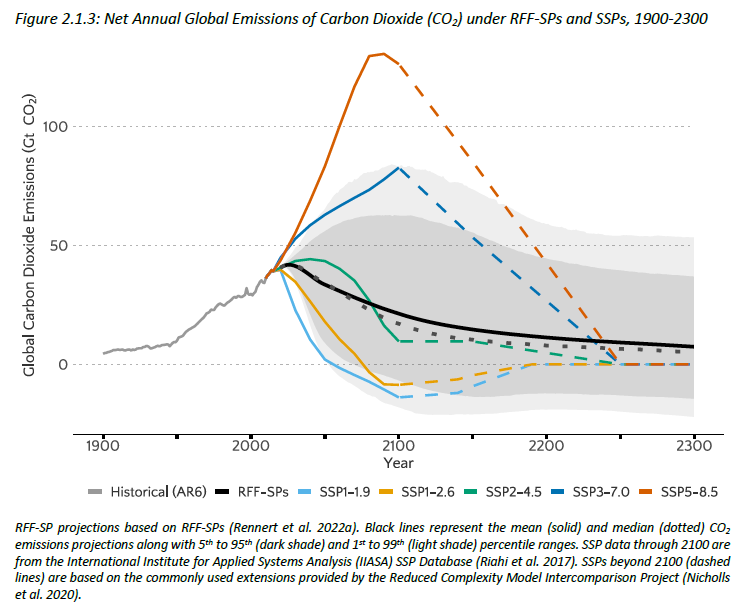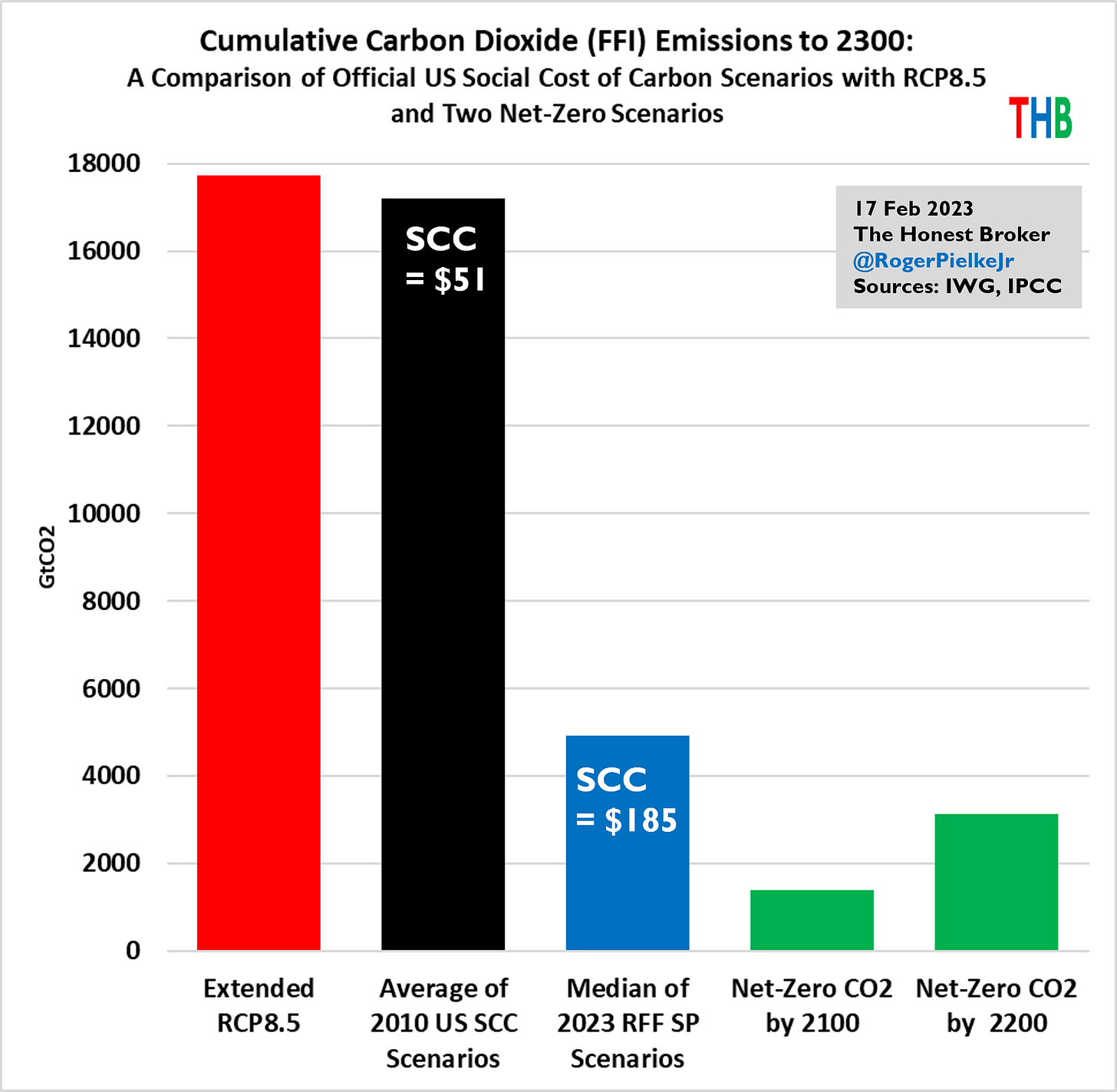The Biden Administration Abandons RCP8.5
Now let's update all the research and policy still based on Zombie science
Readers here will know a lot about the infamous and implausible extreme climate scenario called RCP8.5 that is endemic in research and in policy. For those wanting a bit of the back story have a look at this post, and for more detail have a look at this paper.
Well, I have some good news to report — preliminary, limited and unmentioned, to be sure — but we will take it. The Biden Administration has abandoned RCP8.5 in an update to one of its most important regulatory tools for justifying climate regulation. This is a big effing deal, as President Biden might say. Here are the details.
Late last year, the U.S. Environmental Protection Agency (EPA) announced that it was considering stricter regulations on the oil and natural gas sector. As part of the evidence base informing the development of these regulations the EPA is applying new estimates for the “social cost of carbon” or SCC.
The SCC is a quantification of the economic consequences of the emissions of carbon dioxide for use in benefit-cost analyses of proposed Federal regulations — it is basically an estimate of the costs in dollars to society of the emissions of a ton of carbon dioxide. You can read up on its development over the past 15 years by the U.S. government in this post.
Long time readers here may recall that two years ago I criticized the Biden Administration for its continued use of outdated and implausibly extreme emissions scenarios as a basis for its initial SCC estimates. I concluded: “The current approach and estimate employed by the Biden administration is simply not defensible.” You can see how extreme the scenarios were in those initial estimates in the figure below.

Good news!
The Biden Administration now appears to have agreed with my critique of its use of scenarios, because it has abandoned the five outdated scenarios that were the basis of its initial estimates. In their place the administration is using a new approach to climate scenarios developed by a group called Resources for the Future (RFF).
In justifying its reliance on the RFF methodology, EPA explains:
“based on a review of long-run projections for socioeconomic variables and GHG emissions necessary for damage calculations, the socioeconomic and emissions projections recently developed under the Resources for the Future Social Cost of Carbon Initiative (Rennert et al. 2022a) stand out as being most consistent with the National Academies’ recommendations.”
RFF explained that the original scenarios used by the Obama Administration to develop its SCC were dated and overly simplistic:
“five socioeconomic “scenarios” were not developed with formal probabilities attached but were treated as equally likely. The scenarios did not incorporate the work done by economists, demographers, and statisticians to estimate and quantify uncertainty around long-term economic and population growth”
Let’s take a look at the new scenarios, which (of course) have their own acronym, RFF-SPs and are illustrated in the figure below.

The figure is a bit complicated, but it is well worth understanding. It shows historical carbon dioxide emissions along with projections to 2300 from 5 of the SSP scenarios of the Intergovernmental Panel on Climate Change — in light blue (SSP1-1.9), yellow (SSP1-2.6), green (SSP2-4.5), dark blue (SSP3-7.0) and red (SSP5-8.5). It is this last scenario, the most extreme, that is the most current version of RCP8.5. The figure also shows black lines representing the mean (solid) and median (dashed) emissions of the new RFF-SPs. The grey shaded regions represent the 90th (dark grey) and 99th (lighter grey) percentile ranges of the RFF-SP scenarios.
OK, you still with me?
Three very important things to note here:
The black lines most closely approximate SSP2-4.5, which in other contexts the Biden Administration has identified as climate policy success.
The grey regions representing uncertainties across the RFF-SP scenarios do not get anywhere close to SSP5-8.5. EPA explains: “The SSP5-8.5 projection is the only SSP-RCP pairing with CO2 emissions projections outside the 1st to 99th percentile range of RFF-SPs.” Indeed.
Also of note, the grey regions do not hit “net-zero” carbon dioxide until after 2050, implying that by this metric, the Biden Administration’s goal of net-zero carbon dioxide by 2050 (framed as “keeping the 1.5-degree C temperature goal within reach”) has a <1% chance of occurring.
Why are these three things significant?
First, the Biden Administration now accepts (and indeed is promoting via its approach to the SCC to justify enhanced regulations) that the most likely future for emissions is largely consistent with a scenario that it has often characterized as climate policy success (i.e., RCP4.5). For instance, the Biden Administration continues to use RCP8.5 as our current trajectory and RCP4.5 as a mitigation scenario in the current draft of the U.S. National Climate Assessment. And just a few week’s ago the U.S. Federal Reserve similarly described SSP2-4.5 as a climate mitigation scenario to compare against SSP5-8.5.
Scenario zombies are everywhere. Rooting them out will take a huge effort. The Biden Administration’s new-found appreciation of more plausible climate scenarios now needs to percolate through policies and regulations grounded in the implausibly extreme 8.5 scenarios and outdated views of RCP4.5 as policy success.
Second, the new SCC estimates should put a dagger stake through the heart of SSP5-8.5 and RCP8.5 as scenarios with any real-world significance in practical policy settings. This is not news to anyone who has followed this issue, but it is a major admission by the Biden Administration that its new approach to the SCC could not encompass these extreme scenarios. The 8.5 scenarios can be found everywhere from central bank stress testing to endangered species listings.
I expect that there may be an unanticipated consequence to the new approach to estimating the SCC — whatever other uses the SCC has, its underlying approach to scenarios will now serve as a big hammer for opponents to climate action to use against regulations and policy based on RCP8.5.
Third, the Biden Administration’s new approach to the SCC does not plausibly foresee any likelihood of success with respect to the president’s climate policy targets. Not even close. That can mean one of two things — either the new scenario methodology has accurately handicapped the administration’s targets as implausible, in which case they should be revisited, or, the methodology is inaccurate and has again exaggerated future emissions, with the effect of an inflated SCC. Pick one.
I haven’t said anything about the results of the SCC or its broader underlying methods, about which a lot could be said. We might ask, for instance, how in the world it can possible be that expected future carbon dioxide emissions have dropped in SCC estimates by more than 70% (from the black bar to the blue bar in the figure above) and yet the estimated SCC increased from $51 to $185 — as you can above. You won’t be surprised to learn that RCP8.5 lives on in the secret sauce (aka damage functions) of the new SCC methods.
As Richard Tol, an economist with deep experience in the social cost of carbon, has noted,
Published estimates range from -771tC [dollars per ton of carbon] to +216,035/tC. Research cannot reduce the span of credible estimates by much, as the future is uncertain and ethical parameters are key.
The SCC can be whatever you, I or President Biden wants it to be, and a very science-y justification can be produced in support of this, that or another estimate. Ultimately it is science theater for regulatory policy.
What is most significant — or should be — in the Biden Administration’s latest update of its social cost of carbon is that it has finally accepted, even if implicitly, that RCP8.5 is RIP, the world is much closer to an emissions trajectory consistent with RCP4.5 and net-zero by 2050 seems highly unlikely. These are the realities consistent with current understandings that pragmatic climate policy can be based on.
A closing note, to be perfectly clear, I am not a fan of the notion of a SCC, but even so a price on carbon makes very good sense, and is absolutely necessary for deep decarbonization — something I’ve argued for decades. Second, scientific integrity is non-negotiable, even in the context of noble causes like dealing with climate change.
The analyses you read here at The Honest Broker are reader-supported and reader-shared. I was asked this week on Twitter if I get oil and gas funding for my research. Ha. My only source of research support is from my subscribers here at The Honest Broker. I like it that way. Please consider a subscription (at any level, free included), a gift or a share. Comments welcomed!






Do they ever provide estimates of the costs of constraining energy use and economic growth?
These will be huge, especially for developing countries.
Since so much effort is put into calculating the social cost of carbon, do ypu know of any effort to calculate the social benefit of carbon (SBF)?